BOU AVENUE
Presidential Traverse
While working in Saint-Jean-sur-Richelieu,
Quebec for about three weeks, I had an opportunity to travel to New
Hampshire's White Mountains to hike up Mount Washington, the highest peak
in the northeastern United States. While researching routes, I was
intrigued by the Presidential Traverse--a point-to-point hike that follows parts
of the famed Appalachian Trail (AT) over several summits including Mount
Washington. Depending on the exact route chosen and the number of
summits that may be bagged, the Presidential Traverse entails over 30 kilometres of
hiking and more than 2500 metres of cumulative elevation gain. Huts
along the route make it easy to break the trip over two or three days, but
many
intrepid hikers do the entire traverse in a single long day. Such
hikers usually journey from north to south in order to get the
bulk of the hardest climbing out of the way earlier in the day. The
biggest logistical hurdle is that a car shuttle needs to be arranged.
The Appalachian Mountain Club (AMC) operates a shuttle bus during the
summer months specifically to accommodate one-way hikers, but
unfortunately, the shuttle schedule is not convenient for day-trippers
wanting to get an alpine start. Without camping somewhere overnight
and without a second car, there was no escaping the fact that, to do the
Presidential Traverse in a single day, I was going to be hiking some
parts of it in the dark.This trip
almost did not happen when I nearly gave up trying to find the Enterprise
car rental shop in Saint-Jean late in the day on 3 June 2016. As it
turns out, the shop is a tiny one located in a rather obscure part of a
strip mall, and at the time, it was partially hidden by some nearby
construction work. Once I found the shop though, the rental process
was really fast and easy, and I even got a nice upgrade (2016 Buick
Verano). I was all
set until I got corralled into going out for drinks later that evening
with my co-workers. I had a good time that night, but I got back to
my accommodations much later than I would have liked and got only about
three or four hours of sleep.
I got up early on the morning of 4 June
2016 and made the long drive to Highland Center Lodge, the southern
terminus of the Presidential Traverse. Although the AMC strongly
recommends calling ahead to book a spot on the
shuttle bus, they will
allow walk-ons if space permits. As it was still early in the
hiking season, I had no problems getting a spot on the bus ($23 USD flat fee for
non-AMC members). It took about an hour for the shuttle bus to drop
me off at Appalachia trailhead, the northern terminus of the Presidential
Traverse. The day was already quite warm when I began hiking at 10:09 AM.
Shortly after starting up the trail, I
noticed that I had forgotten to load maps of the area into my GPS.
In my haste to plan this trip, I had also neglected to acquire maps of
any sort, but I was not overly concerned as I knew that there would be
plenty of signage along the traverse. What I failed to realize was
that there are more trails than one, and many of these side trails also
lead to the summits albeit in more roundabout ways. The potential
for confusion is great especially without a map.
From the
Appalachia trailhead, the Valley Way trail rises gently but steadily
through forest along the west bank of Snyder Brook. The warmth and
humidity had me sweating profusely, and I felt weary already at this
early stage. At the
junction with Watson Path, I was a bit confused by a sign pointing the
way to Mount Madison along the side trail. I was uncertain about
where this side trail went, but taking a chance, I followed it anyway.
As it turns out, Watson Path is a more direct route to the summit of
Mount Madison than the Valley Way trail, but it is also very rough and
relentlessly steep. I gained an enormous amount of elevation over a
short distance, but the hike from tree line to the summit of Mount Madison
still seemed to take forever. I eventually topped out at 1:23 PM,
and although it was nice to finally tag my first summit of the day, a quick
glance southward brought home the sobering reality that I had a lot of
walking left ahead of me.
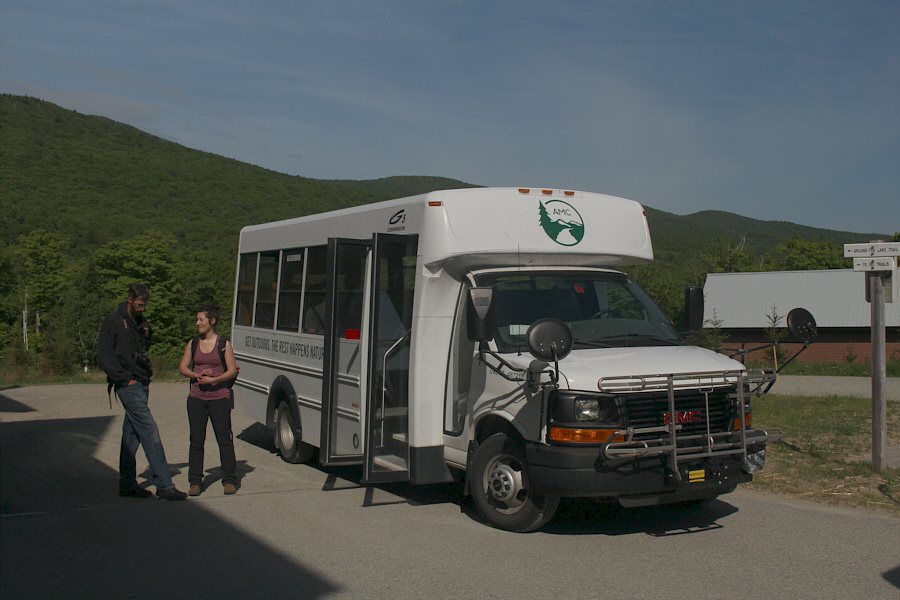 |
A couple of hikers wait to board the
shuttle bus. |
 |
After all the logistics just to get to
the northern terminus of the Presidential Traverse, Sonny is happy to
be finally hiking. |
 |
A short waterfall cascades over some
rocks along Snyder Brook. |
 |
The Watson Path is the most direct
route to the summit of Mount Madison, but it is rough and relentlessly steep. |
 |
A sign at tree line serves as fair
warning to hikers venturing into the "alpine zone". |
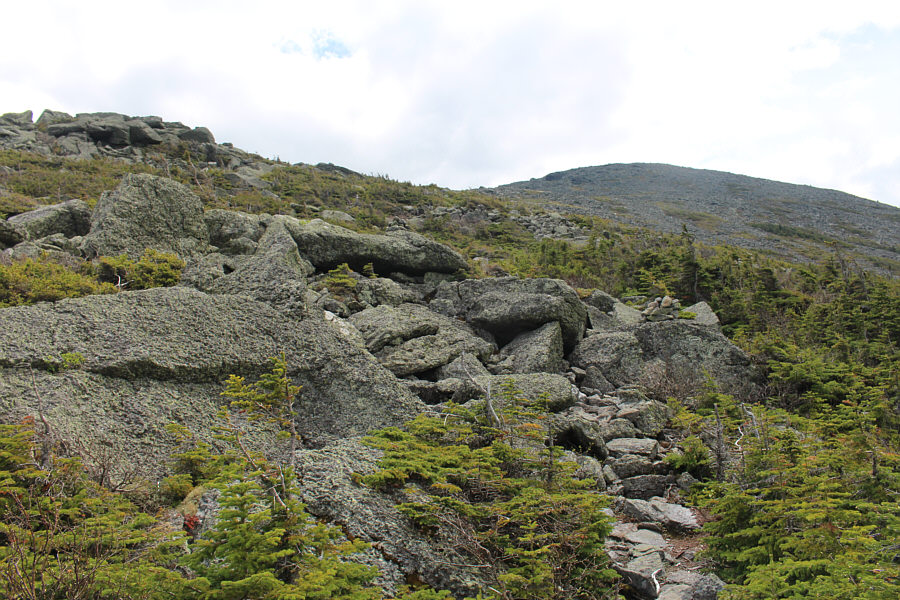 |
The rounded summit of Mount Madison is
visible ahead. |
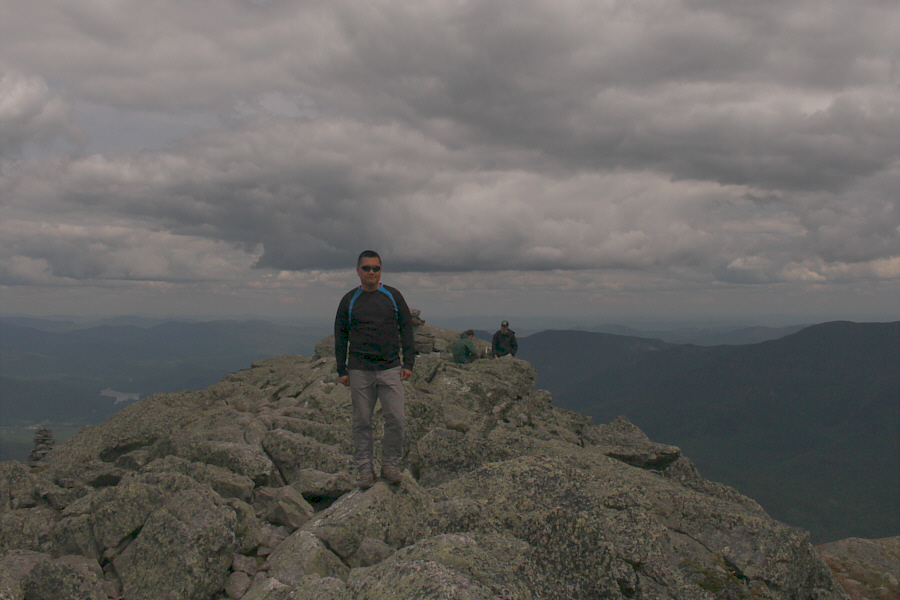 |
Sonny reaches the summit of Mount
Madison (1634 metres). |
 |
Mount Washington is visible to the
southwest. A toll road which runs to the summit is also
visible. |
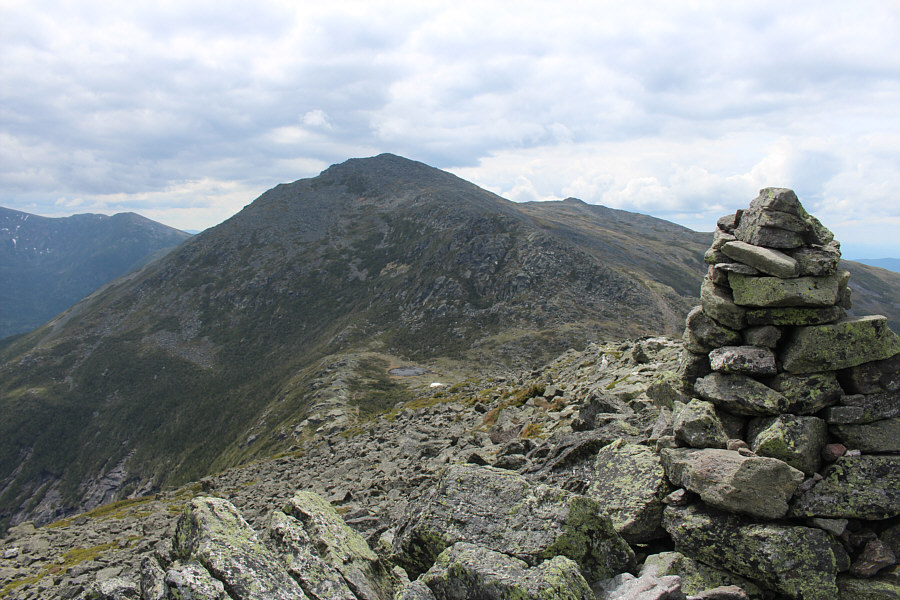 |
Mount Adams is the next objective
along the Presidential Traverse. |
After a brief stop on top of Mount Madison, I quickly dropped
down the southwest ridge and picked up another rugged trail which climbs up
the northeast face of Mount Adams. A few spots along the way
require hands-on scrambling, but otherwise, the route is fairly
straightforward. I reached the summit of Mount Adams at
3:11 PM, and while it would have been nice to linger and socialize with
the crowd of people up there, I felt some urgency to keep moving and
perhaps even pick up my pace.
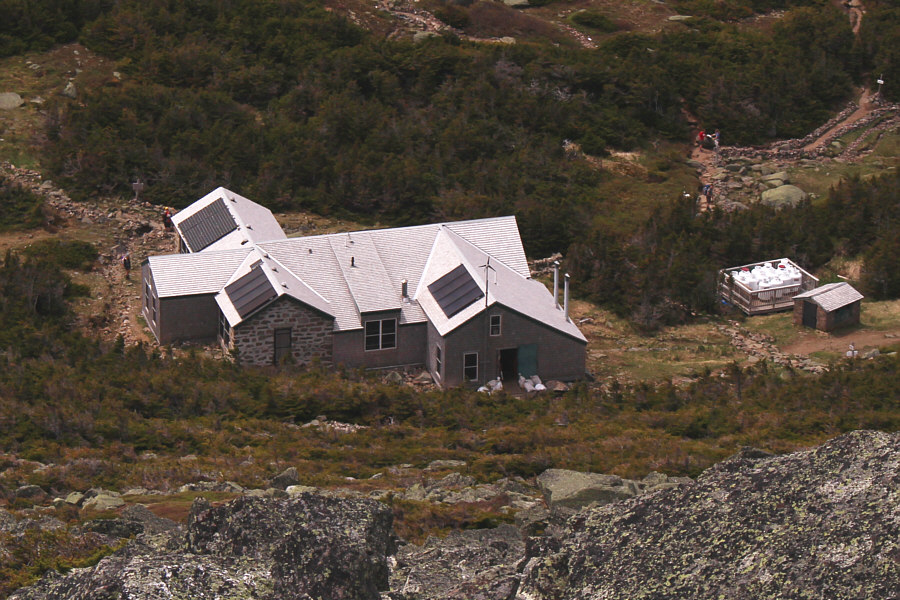 |
Madison Spring Hut is operated by the
AMC and is located near the saddle between Mount
Madison and Mount Adams. |
 |
A very large quartz outcrop sits near
Star Lake below Mount Adams. |
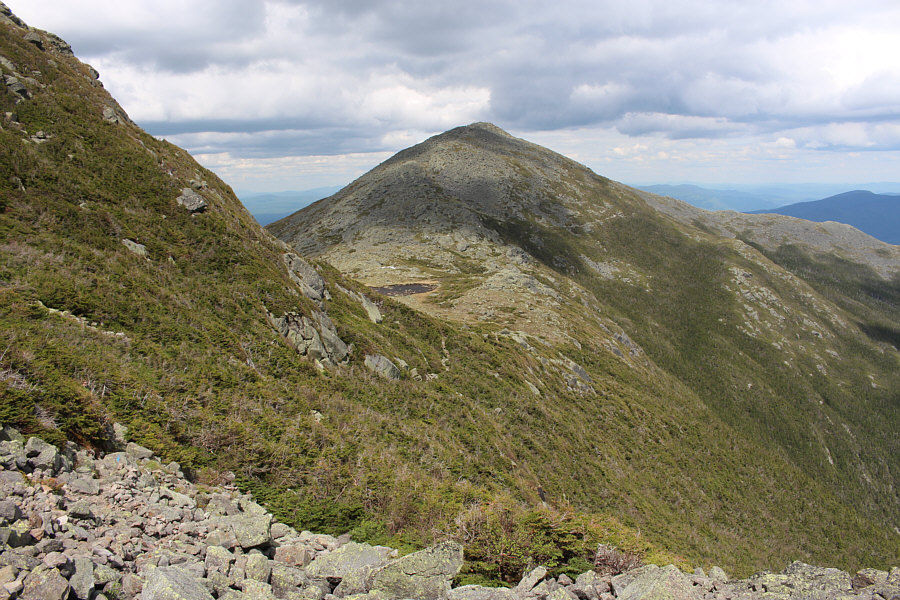 |
This is looking back at Star Lake and
Mount Madison from partway up the trail to Mount Adams. |
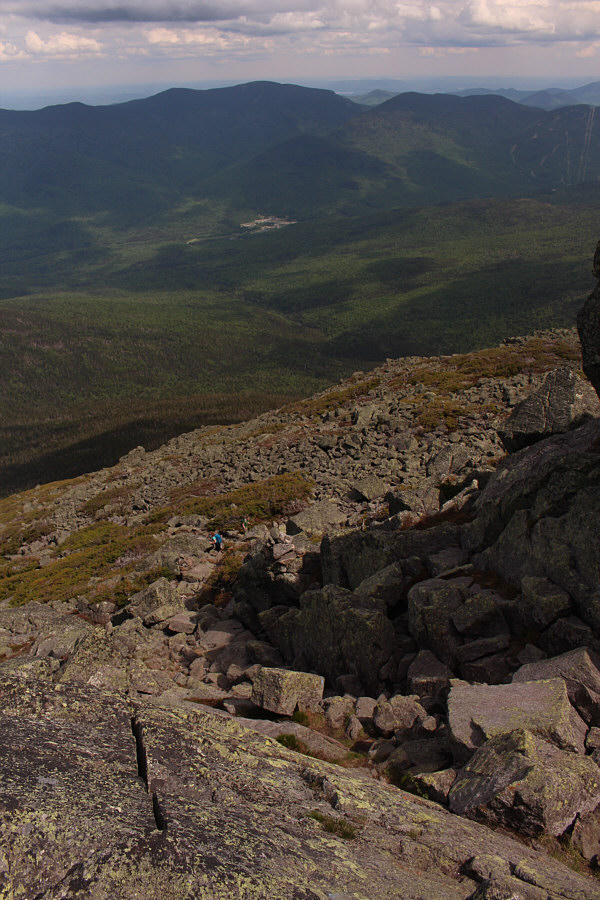 |
A couple of hikers are about to
scramble up a steep rocky gully just below the summit of Mount Adams. |
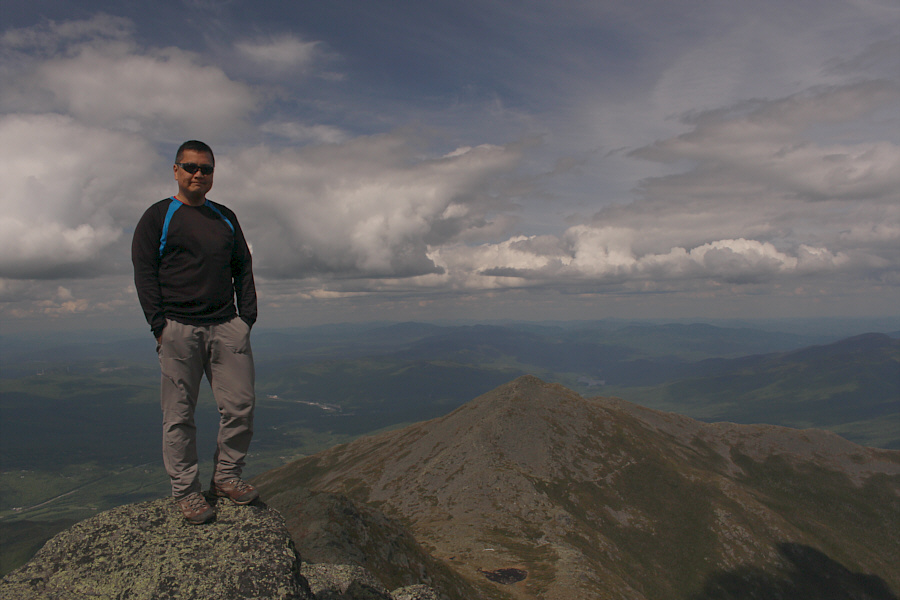 |
Sonny stands near the summit of Mount
Adams (1765 metres) with Mount Madison behind him. |
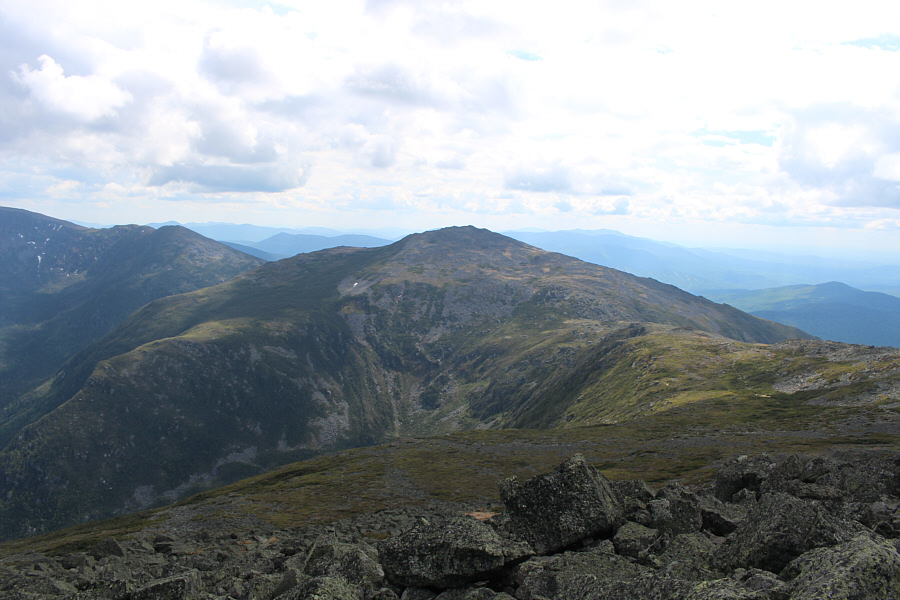 |
Southwest from the summit of Mount
Adams is Mount Jefferson. |
Dropping down the west ridge of Mount Adams, I quickly picked
up the Gulfside Trail which is the name for this particular section of
the AT leading up to Mount Jefferson. As I was making the long,
gentle descent to Edmands Col, I had a chance to take notice of the
rugged nature of the AT, at least as it pertains to the Presidential
Traverse. The AT is marked by numerous
cairns and is easy to follow, but the trail itself is eminently rocky which can
be taxing on the feet, especially over long distances. Furthermore,
the trail constantly demands a certain degree of concentration with
respect to foot placement in order to avoid energy-sapping stumbles or
potential ankle sprains. As far as I can remember, I do not recall ever being
able to "relax" while on the move throughout the Presidential Traverse.
As I bottomed out at Edmands Col and began the stiff climb up Mount
Jefferson, a group of hikers that I had just passed going in the opposite
direction suddenly called out to me. They had apparently heard
someone call for help somewhere in the vicinity. I honestly did not
hear anything, but another group of hikers far above me had also
apparently heard a plea for help. The two separate groups of hikers
began calling out to try and ascertain the location of the person in
distress, and quite frankly, I thought it was rather counter-productive
as their voices reverberated throughout the area making it virtually
impossible to pinpoint anything. After a lot of fruitless calling
back and forth between the two groups, I climbed higher to meet up with
the hikers above me and to get a better vantage point to survey the area.
The vicinity of Edmands Col is largely comprised of sub-alpine vegetation
with very little cover to hide in. Still, I could spot nothing out
of the ordinary. The hikers above me apparently tasked another
hiker to hurry to the top of Mount Washington to notify the authorities
there, but it was uncertain when or if they would even respond with a
rescue party, especially without a missing person report or confirmation
of an injury. I eventually did hear a voice that was seemingly
acknowledging the need for assistance, and there was even a
pathetic-sounding toot from a whistle. We tried to ask the person
their exact whereabouts in relation to Edmands Col, but there were no
coherent responses. Why the person did not keep whistling is a
mystery, and after awhile, I was beginning to wonder if we were just
hearing the distant voices of the group of hikers I had previously
passed. We all eventually agreed that there was not much else for
us to do. The distressed person, if there was one, had stopped
responding, and trying to find someone in that vast amphitheatre was akin
to finding the proverbial needle in a haystack. We all moved on in
hopes that, if a person was reported missing, the authorities would know
roughly where to look (to date, a Google search has yet to turn up any
reports of a person going missing in the White Mountains on 4 June 2016).
After the ordeal at Edmands Col, I continued on to the top of
Mount Jefferson and reached the summit at 5:48 PM. Even this late
in the day, there was still a small crowd of people here, and I
half-wondered about where they were all planning to spend the night.
In fact, I was starting to wonder about where I would be spending the
night.
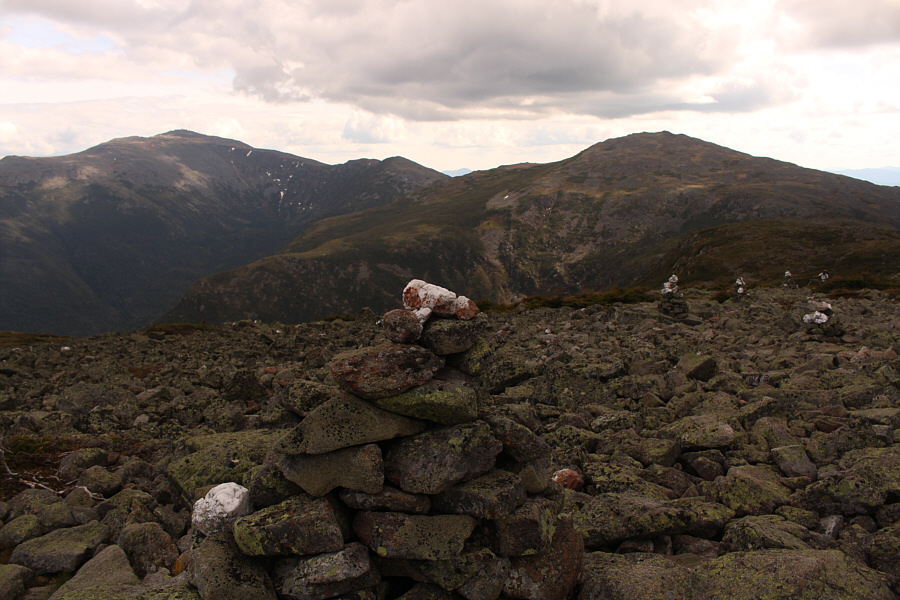 |
Many of the cairns along the
Presidential Traverse are topped with a block of quartz which make
them stand out from the stark landscape. |
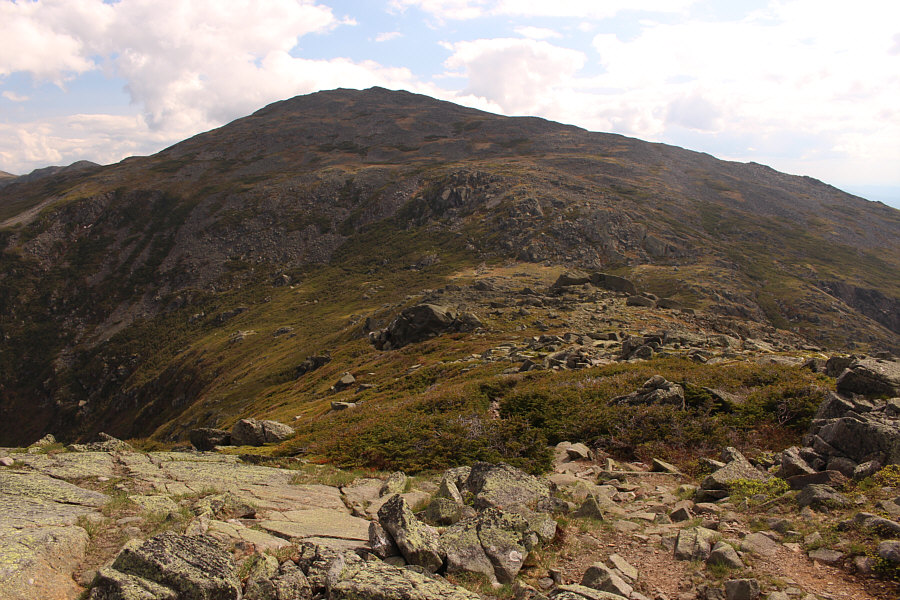 |
This is looking up the northeast face
of Mount Jefferson from Edmands Col. |
 |
This plaque commemorates a founding
member of the AMC. |
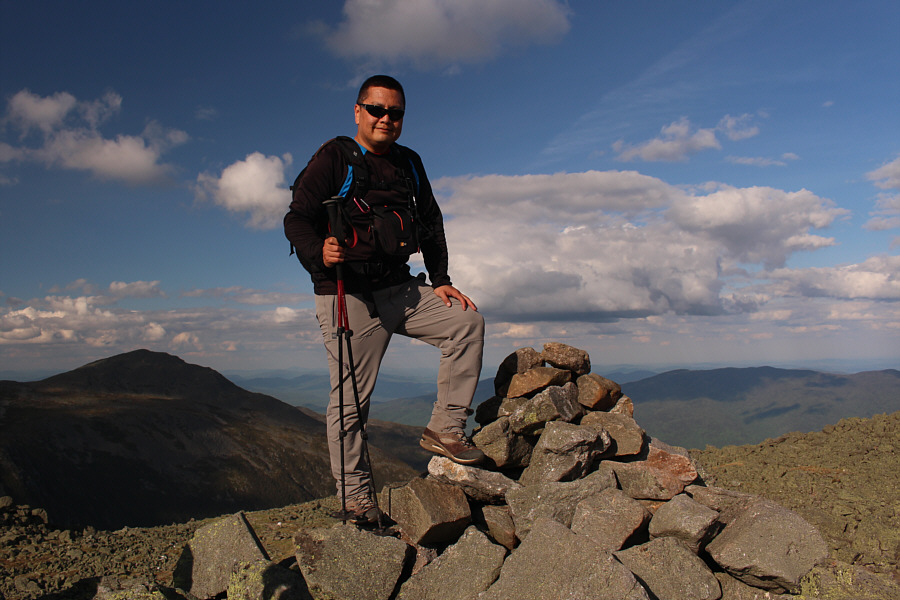 |
Sonny manages a weak smile on the
summit of Mount Jefferson (1740 metres). |
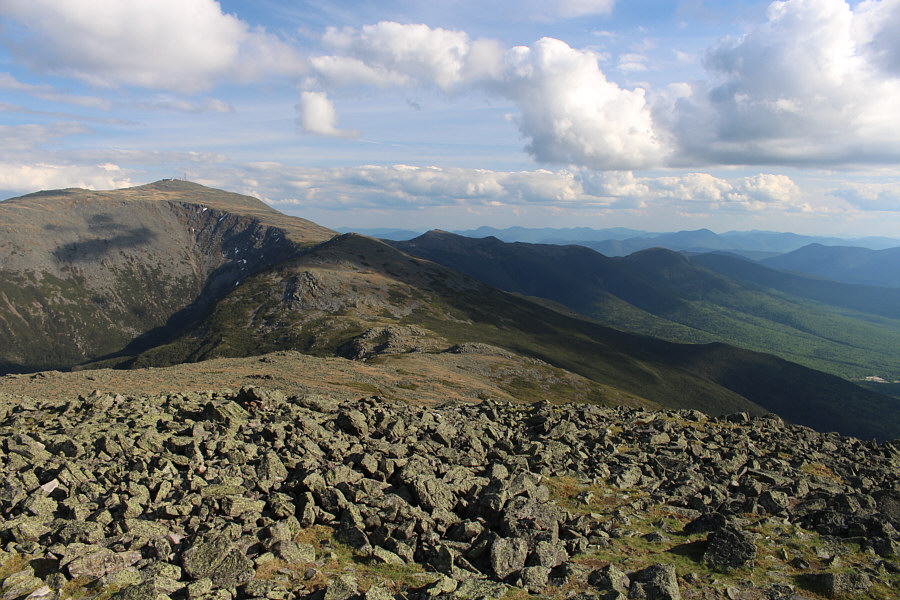 |
Much of the southern half of the
Presidential Traverse is visible to the south from the summit of
Mount Jefferson. At left is Mount Washington. |
By the time I left the summit of Mount Jefferson, the whole
exercise of hiking and bagging peaks was verging on pointlessness.
I was exhausted and my feet were aching. I began envisioning eating
a greasy hamburger and drinking a cold soda at the restaurant on top of
Mount Washington. Thus I deluded myself into thinking there would
be a nice reward if only I could reach the highest point of New
Hampshire. In the meantime, I still had to hike over a minor
intervening bump known as Mount Clay whose summit I reached at 7:19 PM.Incidentally, Mount Clay is named after a US senator and not a US
President, but the state of New Hampshire passed a law in 2003 to have
the name changed to Mount Reagan. Apparently, the new name has not
gained much support from the US Board of Geographic Names or the AMC who
continue to refer to this bump as Mount Clay. It is rare when an
obscure US senator can upstage a famous US President!
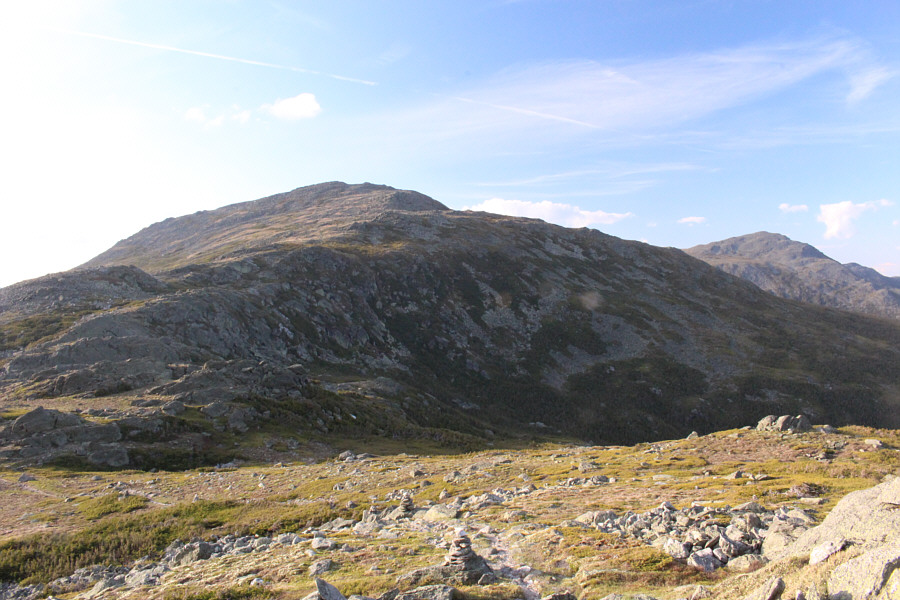 |
This is looking back at Mount
Jefferson (left) and Mount Adams (right) from the slopes below Mount
Clay. |
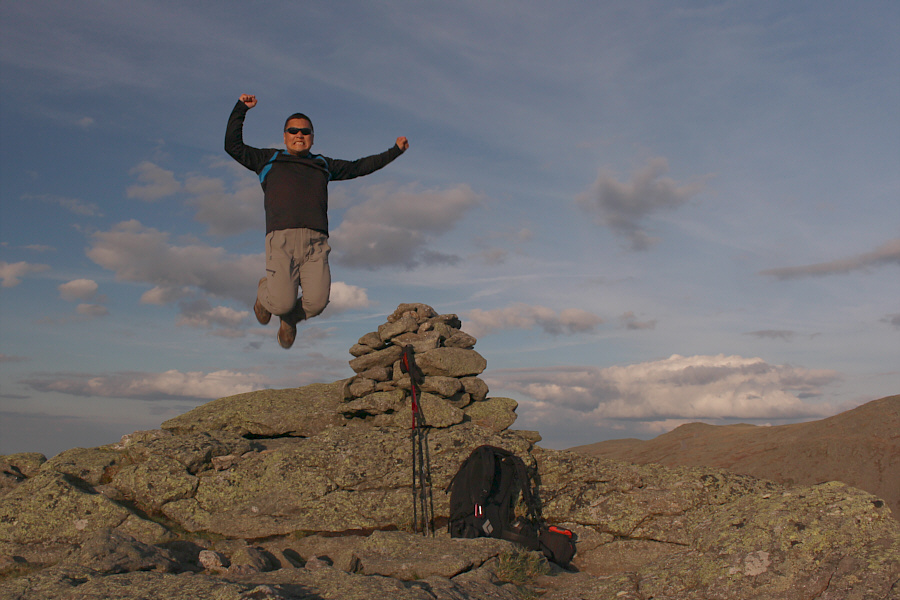 |
Sonny exhibits a rare burst of energy
on the summit of Mount Clay (1684 metres). |
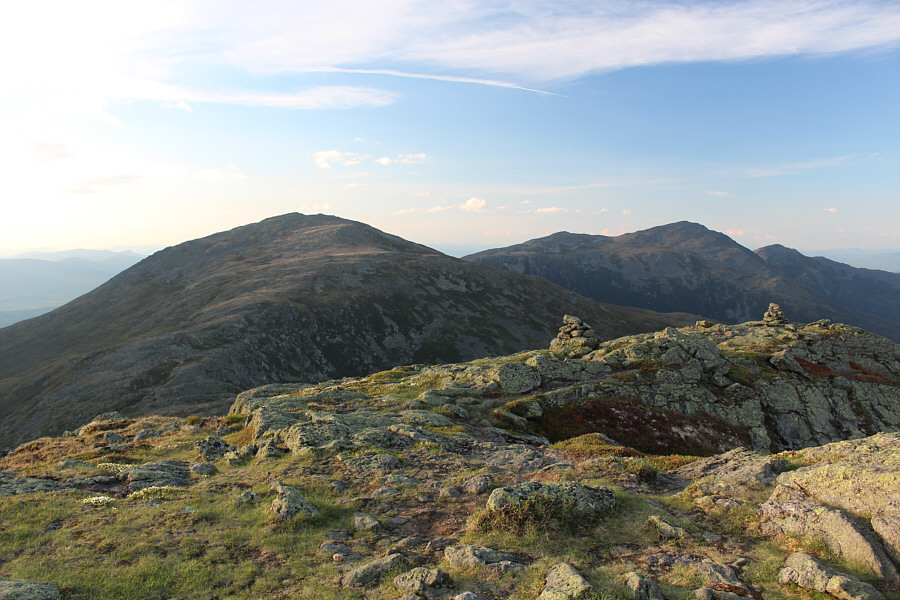 |
Here is another look back at Mount
Jefferson, Mount Adams, and Mount Madison from the summit of Mount
Clay. |
I found a bit of a second wind as I climbed the last few
hundred metres of elevation to the summit of Mount Washington.
The promise of a burger and soda at the summit
restaurant was a good motivator, and so was the excitement of arriving at the apex of the
Presidential Traverse. I even entertained unrealistic thoughts
about sleeping somewhere on the summit for the night.It was eerily
quiet when I finally arrived at the summit of Mount Washington at 8:42 PM.
Normally teeming with tourists and hikers, the summit area was mostly
deserted except for a few workers from the nearby weather observatory.
On most days, there is normally a line-up to take photos beside the summit sign, but I
had it all to myself on this evening. Unfortunately, all the
tourist amenities, including the restaurant, were closed and locked up by
the time I arrived. I was crushed with disappointment, but faced
with no other options other than to continue hiking well into the night,
I took about a 15-minute break to re-hydrate and put on some warm
clothes. Thankfully, I was able to fill my water bottle under an
outdoor tap, and once that was done, I set off down the south side of the
mountain along Crawford Path which is the name for this section of the
AT.
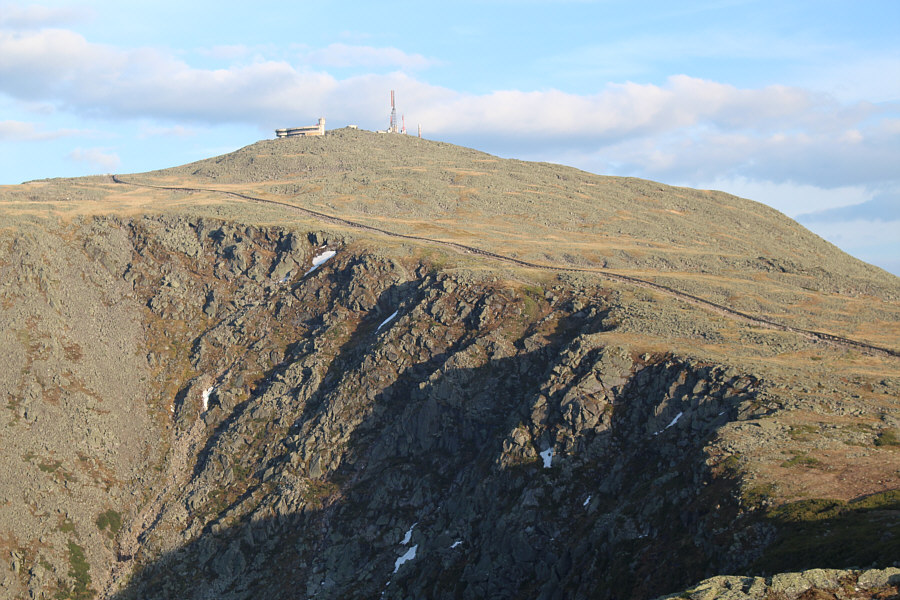 |
The Mount Washington Observatory sits
atop its namesake mountain. Also visible is the Mount
Washington Cog Railway. |

The sun begins to set on the western horizon.
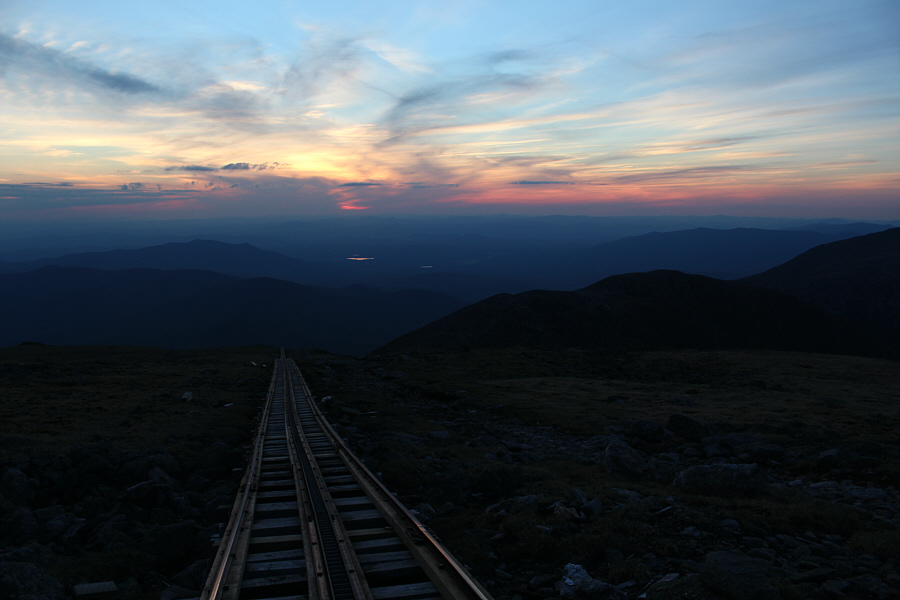 |
The Mount Washington Cog Railway is
the second steepest of its kind in the world. |
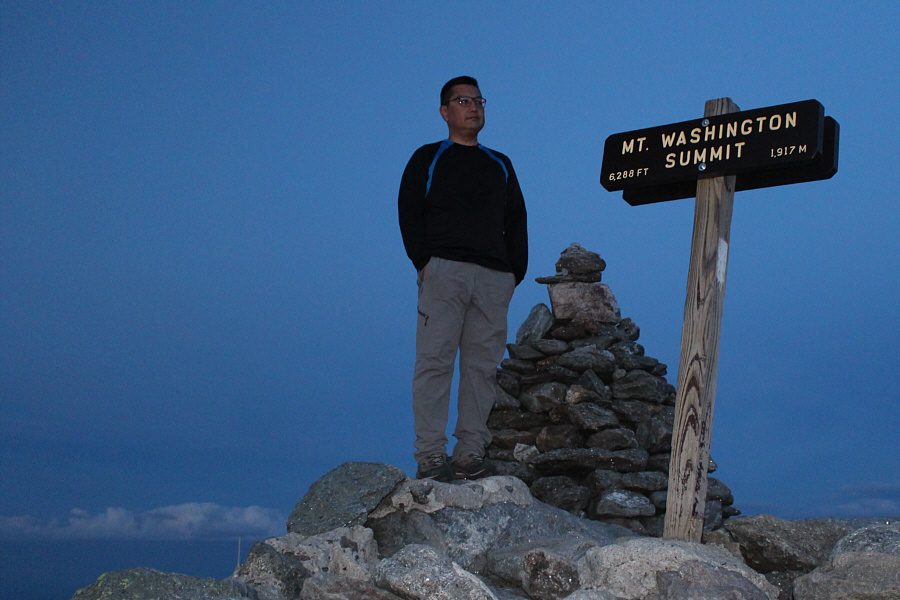 |
Sonny reaches the summit of Mount
Washington (1917 metres) just after sunset. |
Despite the growing darkness, I descended for a considerable
distance without having to use my headlamp. The numerous cairns
topped with a hunk of quartz were very helpful for navigating in the
dark. I eventually switched on my headlamp for good as I approached
the Lakes of the Clouds Hut. I ran into three guys who were
loitering just outside the hut and asked them which way I should go to
continue along the Crawford Path. They were surprisingly unaware of
what the Crawford Path was, but to their credit, they suggested that I
should hunker down for the night at the hut and figure things out in the
morning. I was tempted to take their offer, but I was feeling
pretty good and wanted to keep going despite my sore feet.I guess it
was inevitable that Murphy's law would take effect just when things were
going good because I proceeded to turn down the wrong trail just behind
the hut. Map details in my GPS would have made a huge difference
here, but because I had no reference points, I was going strictly by
trail signs which I had misread in the dark. Fatigue may have also
played a part in my poor decision making. It took quite awhile
before I realized something was amiss as I happily scrambled down a steep
watercourse which was rougher than would be expected for the Crawford
Path. When I had dropped about 175 metres or so, I spotted a trail
sign with a small map which confirmed that I had taken a wrong turn back
at the hut. I had, in fact, partially descended the Ammonosuc Ravine trail. The prospect
of climbing back up to the hut was disheartening, but the alternative of
descending to another trailhead far from my car was seemingly more
unappealing. Actually, had I done my homework and studied the
Ammonosuc Ravine trail more closely, I might have considered continuing
my descent as the walk back to Highland Center from the trailhead is not
unreasonably far (about 8 kilometres on a paved road). Undoubtedly,
it would have added extra distance, but at the same time, walking on
smooth pavement would have felt like heaven compared to the rocky hell of
the Crawford Path. In the end, I opted to climb back up to the hut,
and my wrong turn ended up costing me about an hour.
The peaks of the southern half of the Presidential Traverse are not
nearly as high or as rugged as those in the northern half, and since it
was the middle of the night, I did not see any point in tagging any of
the southern summits even though most of them would have required only
minimal extra effort. In fact, I may have even walked over one of
the summits in the dark without knowing it! As I continued
trudging along the Crawford Path, I still got the sense that this was
probably a marvelous ridge walk on a clear day, and I regretted not
being able to enjoy what surely would have been some amazing vistas.
That might be incentive enough to perhaps return in the future to hike
this part of the traverse again.
Besides the occasional trail junction sign, my only other point of
reference during my hike out was the odometer in my GPS. I knew
that the Presidential Traverse, as I was hiking it, was somewhere
between 30 and 32 kilometres long, and I kept checking my GPS
periodically to monitor how far I had already walked. My progress
was exasperatingly slow, and although I like to think that an
eight-hour walk alone in the dark would be a spiritual experience with
plenty of time to reflect on life and family and friends, the reality
was that I was really f**king tired! During the night, I sat down
a couple of times to have a catnap, but fortunately, I was always able
to rouse myself and limit my stops to only a few minutes at most.
The sky began to brighten up as I descended along the south bank of
Gibbs Brook near the end of the traverse, and my rental car was a sight for sore eyes (and sore feet) when I finally
arrived at Highland Center Lodge at 4:50 AM on the morning of 5 June
2016.
After changing into some fresh clothes, I drove for a bit until I
found a convenience store that was open. I bought a huge cup of
fountain Diet Pepsi and downed a third of it before going to a nearby
rest area to nap for about an hour or so. When I woke up, I felt
refreshed enough to drive the rest of the way back to Saint-Jean
without incident.
 |
Total
Distance: 31.2 kilometres
Total Time: 18 hours 43 minutes*
Total Elevation Gain: 2674 metres*
GPX Data
* Includes about 1 hour and 175 metres added for wrong
turn |



























